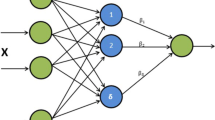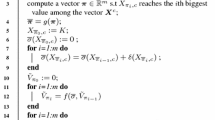Abstract
An obvious defect of extreme learning machine (ELM) is that its prediction performance is sensitive to the random initialization of input-layer weights and hidden-layer biases. To make ELM insensitive to random initialization, GPRELM adopts the simple an effective strategy of integrating Gaussian process regression into ELM. However, there is a serious overfitting problem in kernel-based GPRELM (kGPRELM). In this paper, we investigate the theoretical reasons for the overfitting of kGPRELM and further propose a correlation-based GPRELM (cGPRELM), which uses a correlation coefficient to measure the similarity between two different hidden-layer output vectors. cGPRELM reduces the likelihood that the covariance matrix becomes an identity matrix when the number of hidden-layer nodes is increased, effectively controlling overfitting. Furthermore, cGPRELM works well for improper initialization intervals where ELM and kGPRELM fail to provide good predictions. The experimental results on real classification and regression data sets demonstrate the feasibility and superiority of cGPRELM, as it not only achieves better generalization performance but also has a lower computational complexity.







Similar content being viewed by others
Change history
18 January 2023
Author biography details has been updated.
Abbreviations
- ELM:
-
Extreme learning machine
- SLFN:
-
Single hidden-layer feed-forward network
- BP:
-
Back-propagation
- BLRELM:
-
Bayesian linear regression-based ELM
- GPR:
-
Gaussian process regression
- GPRELM:
-
GPR-based ELM
- 1HNBKM:
-
One hidden-layer nonparametric Bayesian kernel machine
- RBF:
-
Radial basis function
- kGPRELM:
-
Kernel-based GPRELM
- cGPRELM:
-
Correlation-based GPRELM
- SVM:
-
Support vector machine
- LSSVM:
-
Least square SVM
- UCI:
-
University of California, Irvine
- KEEL:
-
Knowledge extraction based on evolutionary learning
- RMSE:
-
Root-mean-square error
- \(\mathrm{{D}}\) :
-
Training data set
- N :
-
Number of instances in \(\mathrm{{D}}\)
- \({\mathrm{{x}}_i}\) :
-
Input of the i-th training instance
- \({\mathrm{{y}}_i}\) :
-
Output of the i-th training instance
- D :
-
Number of instance’s condition attributes
- M :
-
Number of instance’s decision attributes
- \(\mathrm{{W}}\) :
-
Input-layer matrix of ELM
- \({{w_{dl}}}\) :
-
Weight on the link between the d-th input-layer node and the l-th hidden-layer node
- \(\mathrm{{b}}\) :
-
Hidden-layer bias vector of ELM
- \({b_l}\) :
-
Bias of the l-th hidden-layer node
- \(\mathrm{{H}}\) :
-
Hidden-layer output matrix of ELM
- \(\mathrm{{h}}\left( {{\mathrm{{x}}_i}} \right) \) :
-
Hidden-layer output of i-th training instance
- \(\beta \) :
-
Output-layer matrix of ELM
- \(g\left( \cdot \right) \) :
-
Activation function of hidden-layer node
- \(k\left( { \cdot , \cdot } \right) \) :
-
Kernel function
- \(\lambda \) :
-
Kernel radius of kernel function \(k\left( { \cdot , \cdot } \right) \)
- \(\mu \) :
-
Mean of Gaussian distribution
- \(\sigma _N^2\) :
-
Variance of Gaussian distribution
- \(\varepsilon \) :
-
Gaussian noise
- \(\mathrm{{I}}\) :
-
Identity matrix
- \(\mathrm{{C}}\) :
-
Correlation matrix
- \(c\left( { \cdot , \cdot } \right) \) :
-
Correlation function
- \(\mathrm{{Cov}}\left( {\mathrm{{u}},\mathrm{{v}}} \right) \) :
-
Covariance between vectors \(\mathrm{{u}}\) and \(\mathrm{{v}}\)
- \(\mathrm{{Var}}\left( {\mathrm{{u}}} \right) \) :
-
Variance of vector \(\mathrm{{u}}\)
References
Alcalá-Fdez J, Fernandez A, Luengo J, Derrac J, García S, Sánchez L, Herrera F (2011) KEEL data-mining software tool: data set repository, integration of algorithms and experimental analysis framework. J Mult-Valued Logic Soft Comput 17(2–3):255–287
Cao JW, Lin ZP, Huang GB (2012) Self-adaptive evolutionary extreme learning machine. Neural Process Lett 36(3):285–305
Chatzis SP, Korkinof D, Demiris Y (2011) The one-hidden layer non-parametric Bayesian kernel machine, In: Proceedings of IEEE international conference on tools with artificial intelligence, pp 825–831
Fernández-Delgado M, Cernadas E, Barro S, Amorim D (2014) Do we need hundreds of classifiers to solve real world classification problems? J Mach Learn Res 15(1):3133–3181
Fu AM, Dong CR, Wang LS (2015) An experimental study on stability and generalization of extreme learning machines. Int J Mach Learn Cybern 6:1
Fu AM, Wang XZ, He YL, Wang LS (2014) A study on residence error of training an extreme learning machine and its application to evolutionary algorithms. Neurocomputing 146:75–82
Han F, Yao HF, Ling QH (2013) An improved evolutionary extreme learning machine based on particle swarm optimization. Neurocomputing 116:87–93
Hu J, Heidari AA, Shou Y, Ye H, Wang L, Huang X, Wu P (2022) Detection of COVID-19 severity using blood gas analysis parameters and Harris hawks optimized extreme learning machine. Comput Biol Med 142:105166
Huang GB, Chen L, Siew CK (2006) Universal approximation using incremental constructive feedforward networks with random hidden nodes. IEEE Trans Neural Netw 17(4):879–892
Huang GB, Wang DH, Lan Y (2011) Extreme learning machines: a survey. Int J Mach Learn Cybern 2(2):107–122
Huang GB, Zhou HM, Ding XJ, Zhang R (2012) Extreme learning machine for regression and multiclass classification. IEEE Trans Syst Man Cybern B Cybern 42(2):513–529
Huang GB, Zhu QY, Siew CK (2004) Extreme learning machine: a new learning scheme of feedforward neural networks. Proc Int Joint Conf Neural Netw 2:985–990
Huang GB, Zhu QY, Siew CK (2006) Extreme learning machine: theory and applications. Neurocomputing 70(1):489–501
Iosifidis A, Tefas A, Pitas I (2015) On the kernel extreme learning machine classifier. Pattern Recogn Lett 54:11–17
Kasun LLC, Zhou H, Huang GB et al (2013) Representational learning with ELMs for big data. IEEE Intell Syst 28(6):31–34
Lan Y, Soh YC, Huang GB (2009) Ensemble of online sequential extreme learning machine. Neurocomputing 72(13–15):3391–3395
Larrea M, Porto A, Irigoyen E et al (2021) Extreme learning machine ensemble model for time series forecasting boosted by PSO: application to an electric consumption problem. Neurocomputing 452:465–472
Lichman M (2013) UCI machine learning repository. University of California, School of Information and Computer Science, Irvine, CA
Liu N, Wang H (2010) Ensemble based extreme learning machine. IEEE Signal Process Lett 17(8):754–757
Lukasik M, Bontcheva K, Cohn T et al (2019) Gaussian processes for rumour stance classification in social media. ACM Trans Inf Syst 37(2):1–24
Luo JH, Vong CM, Wong PK (2014) Sparse Bayesian extreme learning machine for multi-classification. IEEE Trans Neural Netw Learn Syst 25(4):836–843
Mair S, Brefeld U (2018) Distributed robust Gaussian process regression. Knowl Inf Syst 55(2):415–435
Nguyen V, Gupta S, Rana S, Li C, Venkatesh S (2019) Filtering Bayesian optimization approach in weakly specified search space. Knowl Inf Syst 60(1):385–413
Peng X, Song R, Cao Q, Li Y, Cui D, Jia X, Lin Z, Huang GB (2022) Real-time illegal parking detection algorithm in urban environments. IEEE Trans Intel Transp Syst. https://doi.org/10.1109/TITS.2022.3180225
Rasmussen CE, Williams CKI (2006) Gaussian processes for machine learning. The MIT Press
Silva DNG, Pacifico LDS, Ludermir TB (2011) An evolutionary extreme learning machine based on group search optimization, In: Proceedings of the IEEE congress on evolutionary computation, pp 574–580
Song G, Dai Q, Han X, Guo L (2020) Two novel ELM-based stacking deep models focused on image recognition. Appl Intel 50(5):1345–1366
Soria-Olivas E, Gomez-Sanchis J, Jarman IH, Vila-Frances J (2011) BELM: Bayesian extreme learning machine. IEEE Trans Neural Netw 22(3):505–509
Wang YG, Cao FL, Yuan YB (2011) A study on effectiveness of extreme learning machine. Neurocomputing 74(16):2483–2490
Wilson AG, Adams RP (2013) Gaussian process kernels for pattern discovery and extrapolation. Proc Int Conf Mach Learn 3:1067–1075
Xue J, Zhou S, Liu Q, Liu X, Yin J (2018) Financial time series prediction using \(l\)2, 1RF-ELM. Neurocomputing 277:176–186
Xue XW, Yao M, Wu ZH, Yang JH (2014) Genetic ensemble of extreme learning machine. Neurocomputing 129:175–184
Zhai JH, Xu HY, Wang XZ (2012) Dynamic ensemble extreme learning machine based on sample entropy. Soft Comput 16(9):1493–1502
Zhu QY, Qin AK, Suganthan PN, Huang GB (2005) Evolutionary extreme learning machine. Pattern Recogn 38(10):1759–1763
Acknowledgements
The authors would like to thank the editors and three anonymous reviewers whose meticulous readings and valuable suggestions have helped to improve the paper significantly after two rounds of review. This paper was supported by National Natural Science Foundation of China (61972261), Natural Science Foundation of Guangdong Province (2314050006683), Key Basic Research Foundation of Shenzhen (JCYJ20220818100205012), and Basic Research Foundations of Shenzhen (JCYJ20210324093609026, JCYJ20200813091134001).
Author information
Authors and Affiliations
Contributions
Data Curation, Writing-Review and Editing, XY; Methodology, Writing-Original Draft Preparation, Writing-Review and Editing, YH; Formal Analysis, Writing-Review and Editing, MZ; Investigation, Writing-Review and Editing, PF-V; Supervision, Funding acquisition, JZH.
Corresponding author
Ethics declarations
Conflict of interest
The authors declare that they have no conflict of interest.
Additional information
Publisher's Note
Springer Nature remains neutral with regard to jurisdictional claims in published maps and institutional affiliations.
Rights and permissions
Springer Nature or its licensor (e.g. a society or other partner) holds exclusive rights to this article under a publishing agreement with the author(s) or other rightsholder(s); author self-archiving of the accepted manuscript version of this article is solely governed by the terms of such publishing agreement and applicable law.
About this article
Cite this article
Ye, X., He, Y., Zhang, M. et al. A novel correlation Gaussian process regression-based extreme learning machine. Knowl Inf Syst 65, 2017–2042 (2023). https://doi.org/10.1007/s10115-022-01803-4
Received:
Revised:
Accepted:
Published:
Issue Date:
DOI: https://doi.org/10.1007/s10115-022-01803-4




